#SmartMobility
Explore tagged Tumblr posts
Text

Your next Uber might not have a driver — and it could launch in the Middle East!
Uber has partnered with China's Pony AI to introduce self-driving taxis across the Middle East by 2026. This collaboration aims to revolutionize urban transport by combining Uber's ride-hailing reach with Pony AI’s advanced autonomous vehicle tech, starting in key Gulf cities.
2 notes
·
View notes
Text
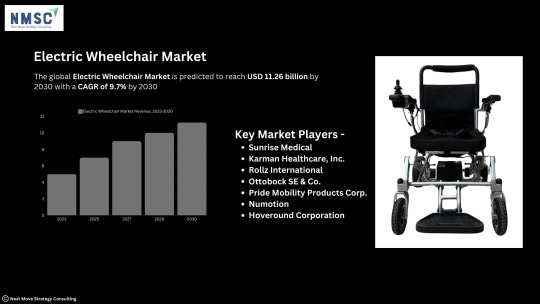
𝐄𝐦𝐛𝐫𝐚𝐜𝐢𝐧𝐠 𝐀𝐜𝐜𝐞𝐬𝐬𝐢𝐛𝐢𝐥𝐢𝐭𝐲: 𝐓𝐡𝐞 𝐆𝐫𝐨𝐰𝐢𝐧𝐠 𝐄𝐥𝐞𝐜𝐭𝐫𝐢𝐜 𝐖𝐡𝐞𝐞𝐥𝐜𝐡𝐚𝐢𝐫 𝐌𝐚𝐫𝐤𝐞𝐭
𝑫𝒐𝒘𝒏𝒍𝒐𝒂𝒅 𝑭𝑹𝑬𝑬 𝑺𝒂𝒎𝒑𝒍𝒆: https://www.nextmsc.com/electric-wheelchair-market/request-sample
As the world prioritizes inclusivity and mobility solutions, the 𝐄𝐥𝐞𝐜𝐭𝐫𝐢𝐜 𝐖𝐡𝐞𝐞𝐥𝐜𝐡𝐚𝐢𝐫 𝐌𝐚𝐫𝐤𝐞𝐭 is witnessing significant growth. These innovative devices not only empower individuals with mobility impairments but also reflect advancements in technology and design.
𝑲𝒆𝒚 𝑻𝒓𝒆𝒏𝒅𝒔 𝑫𝒓𝒊𝒗𝒊𝒏𝒈 𝒕𝒉𝒆 𝑴𝒂𝒓𝒌𝒆𝒕:
𝙏𝙚𝙘𝙝𝙣𝙤𝙡𝙤𝙜𝙞𝙘𝙖𝙡 𝘼𝙙𝙫𝙖𝙣𝙘𝙚𝙢𝙚𝙣𝙩𝙨: Electric wheelchairs are evolving with smart features such as obstacle detection, navigation systems, and connectivity options for enhanced user experience.
𝘾𝙪𝙨𝙩𝙤𝙢𝙞𝙯𝙖𝙩𝙞𝙤𝙣 𝙖𝙣𝙙 𝘾𝙤𝙢𝙛𝙤𝙧𝙩: Manufacturers are focusing on ergonomic designs, adjustable seating options, and lightweight materials to improve comfort and usability.
𝙍𝙞𝙨𝙚 𝙞𝙣 𝘼𝙜𝙞𝙣𝙜 𝙋𝙤𝙥𝙪𝙡𝙖𝙩𝙞𝙤𝙣: With a global increase in aging populations, there's a rising demand for electric wheelchairs that offer independence and mobility support.
𝙍𝙚𝙜𝙪𝙡𝙖𝙩𝙤𝙧𝙮 𝙎𝙪𝙥𝙥𝙤𝙧𝙩: Governments and organizations worldwide are implementing policies and initiatives to promote accessibility and improve the availability of assistive technologies.
𝙎𝙪𝙨𝙩𝙖𝙞𝙣𝙖𝙗𝙞𝙡𝙞𝙩𝙮: Manufacturers are integrating eco-friendly materials and energy-efficient technologies into electric wheelchairs to minimize environmental impact.
The electric wheelchair market is poised for continued expansion, driven by technological innovation, demographic shifts, and a growing awareness of accessibility needs.
𝐊𝐞𝐲 𝐏𝐥𝐚𝐲𝐞𝐫𝐬
· Sunrise Medical
· Karman Healthcare
· Rollz International
· Ottobock
· Pride Mobility Products Corporation
𝐀𝐜𝐜𝐞𝐬𝐬 𝐅𝐮𝐥𝐥 𝐑𝐞𝐩𝐨𝐫𝐭: https://www.nextmsc.com/report/electric-wheelchair-market
Let's work together to create a more inclusive society where everyone can navigate the world with dignity and independence.
#electricwheelchairs#accessibilityinnovation#mobilitysolutions#inclusivedesign#agingpopulation#assistivetechnology#smartmobility#techforgood#healthcareinnovation
4 notes
·
View notes
Text
Explore the key features of modern elevators and escalators designed to enhance safety, efficiency, and user experience in commercial spaces.
1 note
·
View note
Text
#eBikeGo#sustainable#AcerEV#ElectricMobility#UrbanTransport#GreenTech#DrIrfanKhan#EVRevolution#SmartMobility#DelhiEVLaunch#electricvehiclesnews#evtimes#autoevtimes#evbusines
0 notes
Text
Blockchain Driving Automotive Security & Smart Sharing in 2025
0 notes
Text
How AI Is Transforming the Taxi Industry
AI is redefining how taxi services operate—with smarter routing, real-time tracking, predictive pricing, and AI-powered support!
💡 Want to build an intelligent taxi app that customers love? Discover key benefits, use cases, and a step-by-step guide.
0 notes
Text
#innovators#AI integration#Tier 1 suppliers#connected vehicles.#SDV#SoftwareDefinedVehicle#RXJapan#AutomotiveWorld#SmartMobility#FutureOfCars#AutoTech#EVInnovation#ConnectedCars#JapanTech#AutoEVTimes#EmbeddedSystems#AutomotiveSoftware#MobilityTransformation#electronicsnews#technologynews
0 notes
Text
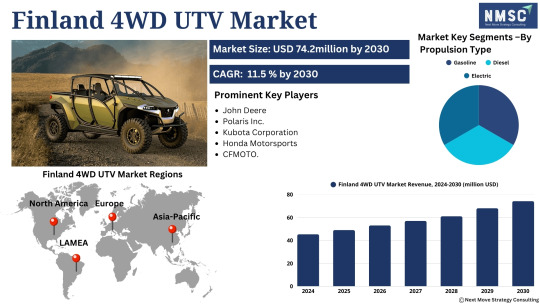
𝗗𝗶𝗱 𝗬𝗼𝘂 𝗞𝗻𝗼𝘄?
𝗙𝗶𝗻𝗹𝗮𝗻𝗱 𝟰𝗪𝗗 𝗨𝗧𝗩 𝗠𝗮𝗿𝗸𝗲𝘁 is on a fast track—from under USD 50 million in 2024 to nearly 𝗨𝗦𝗗 𝟳𝟱 𝗺𝗶𝗹𝗹𝗶𝗼𝗻 𝗯𝘆 𝟮𝟬𝟯𝟬, at a 𝗖𝗔𝗚𝗥 𝗮𝗽𝗽𝗿𝗼𝗮𝗰𝗵𝗶𝗻𝗴 𝟴 %—driven by rising disposable incomes and growing demand for versatile off‑road vehicles in both civilian and defence sectors.
𝗗𝗼𝘄𝗻𝗹𝗼𝗮𝗱 𝗙𝗥𝗘𝗘 𝗦𝗮𝗺𝗽𝗹𝗲 - https://www.nextmsc.com/finland-4wd-utv-market-ad3253/request-sample
𝗪𝗵𝘆 𝗜𝗻𝘃𝗲𝘀𝘁𝗼𝗿𝘀 𝗔𝗿𝗲 𝗪𝗮𝘁𝗰𝗵𝗶𝗻𝗴:
𝗟𝗶��𝗲𝘀𝘁𝘆𝗹𝗲 & 𝗥𝗲𝗰𝗿𝗲𝗮𝘁𝗶𝗼𝗻: Higher household spending is fueling interest in UTVs for outdoor adventures and farm work.
𝗗𝗲𝗳𝗲𝗻𝗰𝗲 & 𝗚𝗼𝘃𝗲𝗿𝗻𝗺𝗲𝗻𝘁 𝗗𝗲𝗺𝗮𝗻𝗱: Increased military budgets are boosting purchases of durable utility vehicles for rough‑terrain operations.
𝗘𝗹𝗲𝗰𝘁𝗿𝗶𝗳𝗶𝗰𝗮𝘁𝗶𝗼𝗻 𝗢𝗽𝗽𝗼𝗿𝘁𝘂𝗻𝗶𝘁𝘆: Electric UTV models promise quieter operation, lower running costs, and alignment with sustainability goals.
𝗦𝗮𝗳𝗲𝘁𝘆 & 𝗥𝗲𝗴𝘂𝗹𝗮𝘁𝗶𝗼𝗻: Advances in roll‑over protection and electronic stability systems are reducing accident risks and expanding appeal among commercial users.
𝗞𝗲𝘆 𝗣𝗹𝗮𝘆𝗲𝗿𝘀 𝗶𝗻 𝗙𝗶𝗻𝗹𝗮𝗻𝗱’𝘀 𝟰𝗪𝗗 𝗨𝗧𝗩 𝗠𝗮𝗿𝗸𝗲𝘁
John Deere
Polaris Inc.
Kubota Corporation
Honda Motorsports
CFMOTO
HISUN
Jiangsu LINHAI Power Machinery
Massimo Motor Sports
Bobcat Company
Toro Company
Kawasaki Heavy Industries
Bad Boy Mowers
Hustler Turf
𝗜𝗻𝘃𝗲𝘀𝘁𝗺𝗲𝗻𝘁 𝗢𝘂𝘁𝗹𝗼𝗼𝗸
With solid growth forecasts and clear sector drivers—rising consumer spending, defence procurement, and the shift to electric powertrains—Finland’s 4WD UTV market offers investors a niche yet high‑potential opportunity. As regulatory standards tighten around vehicle safety and emissions, manufacturers that innovate in electric and hybrid UTVs stand to capture premium margins. Strategic partnerships, localized production, and after‑sales service networks will be key to winning market share through 2030.
#FinlandUTVMarket#OffRoadInvestment#DefenceMobility#ElectrifiedUTVs#OutdoorRecreation#SustainableVehicles#EmergingMarkets#InvestmentOpportunity#AutomotiveInnovation#SmartMobility
0 notes
Text
The drive-by-wire market was worth USD 20.6 billion in 2024 and is expected to reach USD 41.5 billion in 3035 with a CAGR of 6.3% during the forecast period.
#DriveByWire#DriveByWireMarket#AutomotiveElectronics#VehicleAutomation#XByWireTechnology#AutomotiveInnovation#NextGenMobility#SteerByWire#BrakeByWire#ThrottleByWire#ShiftByWire#WireControlSystems#AutonomousVehicles#EVTechnology#SmartMobility#ConnectedVehicles#FutureOfTransportatio
0 notes
Text
Electric Motorcycle Market: The Next Frontier in EV Investment
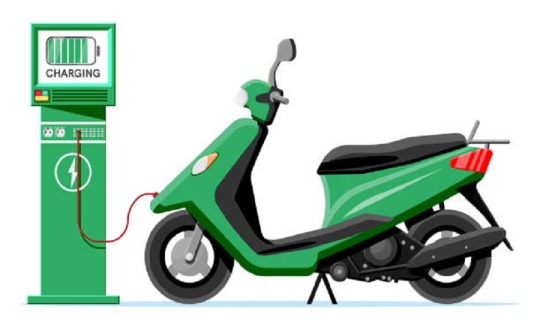
The electric motorcycle market has experienced significant growth in recent years, driven by advancements in technology, environmental concerns, and increasing demand for sustainable transportation solutions. As governments around the world push for reduced emissions and greater environmental sustainability, the electric motorcycle market is poised for continued expansion.
Electric motorcycles, also known as e-motorcycles, are powered by electric motors instead of traditional internal combustion engines. They use rechargeable batteries, typically lithium-ion, to power the motor. As the adoption of electric vehicles (EVs) grows, electric motorcycles represent a growing segment of the broader EV industry, offering a clean, quiet, and energy-efficient alternative to conventional motorcycles.
Get a Free Sample Copy - https://www.skyquestt.com/sample-request/electric-motorcycle-market
Market Size
The global electric motorcycle market has seen substantial growth over the past few years and is projected to continue expanding at a rapid pace. In 2024, the market size was valued at $17.24 billion. By 2032, the market is expected to reach a valuation of $40.56 billion, growing at a compound annual growth rate (CAGR) of 11.6% from 2025 to 2032.
This growth is primarily driven by the increasing adoption of electric vehicles (EVs) worldwide, government incentives, and technological advancements in battery systems and charging infrastructure. Additionally, the rising awareness of environmental issues, such as climate change and air pollution, is driving consumer interest in eco-friendly transportation options like electric motorcycles.
Market Drivers
1. Environmental Concerns: The global push for cleaner energy and reduced carbon emissions is one of the main drivers behind the growth of the electric motorcycle market. Electric motorcycles produce zero emissions, making them a popular choice for consumers and businesses aiming to reduce their carbon footprints.
2. Government Initiatives and Incentives: Governments across the globe are increasingly supporting the adoption of electric motorcycles by offering subsidies, tax incentives, and infrastructure development programs. For instance, countries like China, India, and several European nations have introduced incentives to promote the use of electric vehicles (EVs), including electric motorcycles.
3. Advancements in Battery Technology: One of the key challenges for electric motorcycles has been range anxiety and charging time. However, recent advancements in lithium-ion battery technology have greatly improved the range and efficiency of electric motorcycles. As battery costs decrease and charging infrastructure improves, the appeal of electric motorcycles continues to rise.
4. Rising Fuel Prices: As fuel prices continue to rise, electric motorcycles offer a more economical alternative to traditional motorcycles, which are reliant on gasoline. Electric motorcycles are cheaper to maintain and operate, making them an attractive option for budget-conscious consumers.
5. Urbanization and Traffic Congestion: In densely populated urban areas, electric motorcycles offer a solution to traffic congestion. With their smaller size and ability to navigate through narrow streets, e-motorcycles are becoming an increasingly popular mode of transport for urban commuters.
Make an Inquiry to Address your Specific Business Needs - https://www.skyquestt.com/speak-with-analyst/electric-motorcycle-market
Market Segmentation
The electric motorcycle market can be segmented based on various factors such as type, battery type, application, and region.
1. By Type:
- Battery Electric Motorcycles (BEVs): These motorcycles are fully electric and require no fuel other than electricity. BEVs are expected to dominate the market due to their eco-friendly nature and long-term cost benefits.
- Plug-in Hybrid Electric Motorcycles (PHEVs): PHEVs combine an electric motor with a traditional internal combustion engine. While these are less common, they are gaining popularity as a transition option for consumers not yet ready to adopt full-electric motorcycles.
2. By Battery Type:
- Lithium-Ion Batteries: This is the most common type of battery used in electric motorcycles due to their high energy density, longevity, and relatively low cost.
- Lead-Acid Batteries: Although less efficient than lithium-ion, lead-acid batteries are still used in low-cost electric motorcycles, particularly in developing regions.
3. By Application:
- Commuter Motorcycles: These are the most common type of electric motorcycles used for daily transportation. Their popularity is particularly high in urban areas, where they are used to avoid traffic congestion and reduce commuting costs.
- Recreational Motorcycles: These electric motorcycles are used for leisure activities such as off-road biking and motorcycling sports.
- Delivery Motorcycles: E-motorcycles are increasingly used by delivery services for last-mile delivery, as they are cheaper to operate and maintain compared to traditional gasoline-powered motorcycles.
4. By Region:
- Asia-Pacific (APAC): This region leads the electric motorcycle market, primarily due to the high adoption rates in China and India. China is the largest market for electric two-wheelers, including motorcycles, due to its significant government subsidies and incentives.
- Europe: Europe is a key market for electric motorcycles, driven by strong regulatory support, such as the European Union's Green Deal and a growing trend toward sustainable transportation in cities like Amsterdam and Paris.
- North America: The electric motorcycle market in North America is still in its early stages but is expected to grow significantly in the coming years, driven by increasing environmental awareness and the development of EV infrastructure.
- Rest of the World: Other regions, including Latin America and the Middle East, are expected to witness gradual growth as electric motorcycles become more accessible and affordable.
Take Action Now: Secure Your Electric Motorcycle Market Today - https://www.skyquestt.com/buy-now/electric-motorcycle-market
Key Challenges
1. High Initial Cost: Although the total cost of ownership of an electric motorcycle is typically lower than that of traditional motorcycles, the initial purchase cost remains relatively high. However, with advancements in manufacturing processes and economies of scale, prices are expected to decrease over time.
2. Charging Infrastructure: The availability of charging stations is a major concern for the widespread adoption of electric motorcycles, particularly in rural or less-developed regions. The expansion of charging networks is crucial for the growth of the market.
3. Limited Range: While electric motorcycles' ranges have improved with better battery technology, they still generally offer a shorter range than gasoline-powered motorcycles. This limits their appeal for long-distance travel.
Competitive Landscape
The electric motorcycle market is highly competitive, with numerous players operating at regional and global levels. Some of the leading companies in the market include:
- Zero Motorcycles: Known for producing high-performance electric motorcycles, Zero is one of the key players in the premium electric motorcycle segment.
- Harley-Davidson: The iconic American motorcycle manufacturer has entered the electric motorcycle market with its LiveWire electric motorcycle, signaling a strong push into the electric vehicle space.
- NIU Technologies: Based in China, NIU is a major player in the global electric scooter and motorcycle market, offering both high-performance and affordable models.
- Energica Motor Company: Energica is an Italian manufacturer of high-performance electric motorcycles, focusing on both sport and touring segments.
Key Players in Electric Motorcycle Industry
Zero Motorcycles
Harley-Davidson, Inc.
Lightning Motorcycles
Alta Motors
LITO Motorcycles
Essence Motorcycles
TACITA SRL
Yadea Group Holdings Ltd.
Gogoro Inc.
NIU Technologies
BMW Motorrad
KTM AG
Honda Motor Co., Ltd.
Yamaha Motor Co., Ltd.
Suzuki Motor Corporation
Kawasaki Heavy Industries, Ltd.
Hero Electric
Ather Energy
Future Outlook
The electric motorcycle market is expected to continue its upward trajectory, driven by a combination of favorable government policies, advances in battery technology, and growing consumer demand for sustainable transportation options. With increasing adoption in both developed and developing regions, the market will see more innovation and competition, leading to better products and lower prices for consumers. By 2032, electric motorcycles are expected to be a common sight on roads worldwide, with an increasing number of people making the switch to electric two-wheelers.
Read Electric Motorcycle Market Report Today - https://www.skyquestt.com/report/electric-motorcycle-market
The electric motorcycle market offers significant growth potential, with a bright future driven by sustainability goals, consumer preferences for eco-friendly transportation, and continued innovation in EV technology. As the market matures, it will provide a cleaner, greener alternative to conventional motorcycles while contributing to the global shift toward electric mobility.
#ElectricMotorcycles#EMotorcycleMarket#EVTwoWheelers#ElectricBikes#EVMarketGrowth#SustainableMobility#GreenTransportation#ZeroEmissions#CleanEnergy#EcoFriendlyVehicles#EVInvesting#EVIndustry#ElectricMobility#BatteryTechnology#EVInnovation#LithiumIonBatteries#FutureOfTransport#SmartMobility#APACEVMarket#IndiaEV#ChinaEV#EuropeEV#USAElectricVehicles#EVCommuting#MotorcycleTech
0 notes
Text
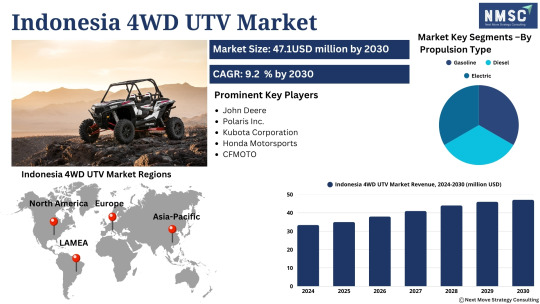
𝐈𝐧𝐝𝐨𝐧𝐞𝐬𝐢𝐚 𝐔𝐓𝐕 𝐌𝐚𝐫𝐤𝐞𝐭 𝐀𝐜𝐜𝐞𝐥𝐞𝐫𝐚𝐭𝐞𝐬: 𝐅𝐫𝐨𝐦 𝐓𝐫𝐚𝐢𝐥𝐬 𝐭𝐨 𝐓𝐚𝐜𝐭𝐢𝐜𝐚𝐥 𝐌𝐢𝐬𝐬𝐢𝐨𝐧𝐬
𝙂𝙧𝙖𝙗 𝙖 𝙁𝙍𝙀𝙀 𝙎𝙖𝙢𝙥𝙡𝙚: https://www.nextmsc.com/indonesia-4wd-utv-market-at3257/request-sample
As Indonesia’s tourism, agriculture, and defense sectors evolve, the demand for 4‑wheel drive Utility Terrain Vehicles (UTVs) is accelerating, driven by rugged terrain, expanding public services, and a growing focus on eco‑friendly solutions.
𝐊𝐞𝐲 𝐆𝐫𝐨𝐰𝐭𝐡 ��𝐫𝐢𝐯𝐞𝐫𝐬
1. 𝙏𝙤𝙪𝙧𝙞𝙨𝙢 𝘽𝙤𝙤𝙢: Indonesia’s diverse landscapes—from Bali’s rugged trails to eco-parks—are fueling UTV demand for off-road adventure tours and rental services.
2. 𝘿𝙚𝙛𝙚𝙣𝙨𝙚 & 𝙋𝙪𝙗𝙡𝙞𝙘 𝙎𝙚𝙘𝙩𝙤𝙧: Rising military and government expenditure—including terrain mobility, patrols, and logistics—is propelling the utility segment forward.
3. 𝙀𝙡𝙚𝙘𝙩𝙧𝙞𝙘 𝙎𝙝𝙞𝙛𝙩: Electric UTVs such as Volcon’s HF1 are gaining traction for their lower emissions, quieter operation, and alignment with Indonesia’s EV infrastructure push.
𝘼𝙘𝙘𝙚𝙨𝙨 𝙁𝙪𝙡𝙡 𝙍𝙚𝙥𝙤𝙧𝙩: https://www.nextmsc.com/report/indonesia-4wd-utv-market-at3257
𝐂𝐡𝐚𝐥𝐥𝐞𝐧𝐠𝐞𝐬 𝐀𝐡𝐞𝐚𝐝
1. 𝙎𝙖𝙛𝙚𝙩𝙮 & 𝙏𝙧𝙖𝙞𝙣𝙞𝙣𝙜 𝙉𝙚𝙚𝙙𝙨: Off-road users face elevated risk, creating demand for improved safety features, operator training, and regulatory oversight.
2. 𝙇𝙞𝙢𝙞𝙩𝙚𝙙 𝙏𝙧𝙖𝙞𝙡 𝙄𝙣𝙛𝙧𝙖𝙨𝙩𝙧𝙪𝙘𝙩𝙪𝙧𝙚: Inconsistent trail access and environmental regulations constrain recreational use in many regions.
𝐄𝐦𝐞𝐫𝐠𝐢𝐧𝐠 𝐓𝐫𝐞𝐧𝐝𝐬
1. 𝙎𝙢𝙖𝙧𝙩 & 𝘾𝙤𝙣𝙣𝙚𝙘𝙩𝙚𝙙 𝙁𝙚𝙖𝙩𝙪𝙧𝙚𝙨: Integration of GPS, telematics, ride tracking, and diagnostics is enhancing vehicle performance and oversight.
2. 𝙀𝙡𝙚𝙘𝙩𝙧𝙞𝙘 & 𝙈𝙤𝙙𝙪𝙡𝙖𝙧 𝙐𝙏𝙑𝙨: Locally developed models like Modultrax (from ITB) offer modular cargo configurations and off-grid electric performance, showcasing Indonesian innovation in sustainable mobility.
#IndonesiaUTVs#ElectricUTV#AdventureTourism#SmartMobility#DefenseLogistics#SustainableTransport#OffRoadInnovation
0 notes
Text
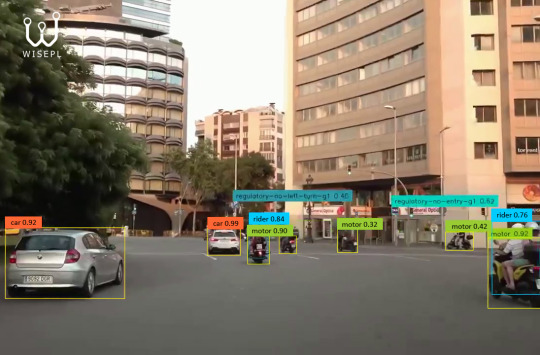
Fuel the Future: Annotate the Road to Autonomy
From bustling cityscapes to winding rural roads, autonomous vehicles rely on more than sensors - they rely on vision with context. We don’t just label objects - we engineer clarity for machines navigating the chaos of real-world driving.
Our Annotation Arsenal:
2D & 3D Bounding Boxes | Semantic & Instance Segmentation | Lane Markings, Road Signs, Pedestrian Paths | LiDAR Point Cloud Tagging | Sensor Fusion Alignment | Edge Case Scenarios & Weather Variants
No shortcuts. No automation-only pipelines. Just expert-crafted datasets for smarter, safer AV systems.
Whether you are training perception models or building high-fidelity maps - Wisepl is your annotation co-pilot.
Let’s accelerate your vision - one frame at a time. Partner with Wisepl now. [email protected]
#AutonomousVehicles#DataAnnotation#ComputerVision#SelfDrivingCars#LiDAR#MachineLearning#SmartMobility#AVTrainingData#SensorFusion#AIforTransportation#Wisepl#PerceptionModels#ADAS#AIDataServices#DriveTheFuture#ImageAnnotation#BoundingBox#DataLabeling#AnnotationPartner
0 notes
Text
#innovators#embedded systems#AI integration#Tier 1 suppliers#SDV#SoftwareDefinedVehicle#RXJapan#AutomotiveWorld#SmartMobility#FutureOfCars#AutoTech#EVInnovation#ConnectedCars#JapanTech#AutoEVTimes#EmbeddedSystems#AutomotiveSoftware#MobilityTransformation#electricvehiclesnews#evtimes#autoevtimes#evbusines
0 notes
Text
#Infineon#XENSIV#3DSensor#Automotive#IndustrialAutomation#ConsumerElectronics#FunctionalSafety#IoT#SmartMobility#powerelectronics#powermanagement#powersemiconductor
0 notes
Text
Integration of ADAS features into VCUs
Introduction

Modern cars must now feature Integration of ADAS features into VCUs to increase efficiency, comfort, and safety. These systems need to be completely integrated into Vehicle Control Units (VCUs), the centralized “brains” of advanced and electric cars, in order to reach their full potential. The end-to-end integration process is covered in length in this piece, along with important factors, software and hardware tactics, industry best practices, and upcoming difficulties.
1. Describe a VCU and Explain Its Significance for ADAS
Similar to a computer CPU, a Vehicle Control Unit (VCU) is a high-performance embedded system that coordinates vital vehicle operations, including energy distribution, motor control, diagnostics, and safety features. It incorporates data from the Motor Controller, Thermal Management, Battery Management System (BMS), ADAS modules, and other sources in electric vehicles.
High-speed data flow, real-time control algorithms, and seamless interface with several sensors and ECUs are all requirements for a modern VCU. The job of the VCU becomes more crucial and intricate as ADAS technologies evolve, adding components like autonomous parking, collision avoidance, and lane centring.
2. Feature Scoping and Requirements Analysis
Determining which Integration of ADAS features into VCUs the car will support is the first step towards effective integration. Examples include:
Adaptive Cruise Control (ACC)
LDW/LKA: Lane Departure Warning/Assist
Automatic Emergency Braking (AEB)
Cross-traffic and blind-spot alerts
Automated Parking and Parking Assistance
CACC, or cooperative adaptive cruise control, uses V2X communication.
The choice of sensors, actuators, VCU computational needs, and communication interfaces is influenced by this scoping process. In addition, it directs adherence to regional rules, AUTOSAR middleware, and safety standards like as ISO 26262 (ASIL requirements).
3. Integration and Calibration of Sensors

A variety of sensor types are necessary for a strong ADAS:
Cameras to identify objects or lanes
Radar for distance and speed, both short- and long-range
Using LiDAR for accurate 3D mapping
Ultrasonic sensors for environments with low speeds
To ensure seamless fusion and dependability, these sensors must be connected via high-speed buses (such as CAN, Ethernet) and carefully calibrated — physically aligned and time-synchronized.
4. Environment Modelling & Sensors Integration
Inputs are combined using sensor fusion to provide a coherent picture of the vehicle environment. Included in this multi-layered data process are:
Pre-processing includes timestamp alignment, distortion correction, and noise filtering.
Tracking and object detection: recognize cars, people, and lane markings
Fusion algorithms are AI-driven or probabilistic techniques that integrate sensor data.
Environmental modeling: make a map of dynamic things in real time
Using perception to inform decision-making, apply alerts or active controls.
Reliance on numerous sensors enhances system durability, and accurate fusion is particularly important in bad weather or low light.
5. Development of Algorithms and Real-Time Control
ADAS algorithms must adhere to stringent real-time performance requirements for operations including lane-keeping, braking, acceleration, and parking. Usually, VCUs execute code that:
Responds with a millisecond lag to sensor inputs
carries out control procedures, such as model predictive control and PID loops.
controls the dynamics of the vehicle to prevent oscillations and guarantee string stability, which is (crucial for CACC.)
Additionally, emergency shutdown procedures, sensor cross-validation, and fallback techniques are necessary for robust control.
6. VCU Architecture & Hardware Selection
Selecting or creating the right VCU hardware is essential. Some items to consider are:
Processing power and SoCs: For modular expansion, tiered ADAS frequently depends on scalable technologies such as Mobileye’s EyeQ6H-based ECUs.
Power and thermal management: VCUs need to be able to control heat production, fit into limited spaces, and keep power levels constant.
Interfaces: Interfaces include a real-time clock, watchdog systems, ADC/DAC channels, and several CAN, LIN, and gigabit Ethernet interfaces.
Memory & Storage: Sufficient RAM and storage to enable middleware, ML models, logs, and diagnostic information to function.
Redundancy: Standby cores and hardware fault tolerance, particularly for safety-critical ADAS tasks
According to industry observations by TomTom and Mobileye, centralized ADAS domain controllers — capable of combining data and making intricate decisions — are increasingly replacing dispersed ECUs.
7. Middleware & Software Integration
Rarely does VCU software architecture run on bare metal. Instead, to handle necessary services, manufacturers frequently use on frameworks like AUTOSAR Adaptive/Classic:
OS scheduling for activities in real time
CAN/LIN/Ethernet/IP protocols make up the networking stack.
OTA updates, logging, and diagnostics
Security procedures, state management, and memory protection
In addition, modularity, reusability, and scalability are ensured by using standardized APIs, which are essential for adding new ADAS capabilities and adhering to legal requirements.
8. Integration of ADAS features into VCUs with Onboard Systems
The VCU and other ECUs must communicate seamlessly for ADAS capabilities to function:
Command flow to steering, throttle, and brake systems via CAN/LIN buses
Ethernet: used for LiDAR or high-data-rate cameras
V2X and C-V2X stacks are necessary for smart traffic integration and CACC.
Additionally, the VCU serves as a gateway, combining vehicle data for telematics, OTA, or diagnostics.
9. Simulation, Validation, and Testing
Extensive verification is essential:
Simulate sensor data and vehicle dynamics using hardware-in-the-loop (HIL) and software-in-the-loop (SIL).
Closed-course testing: adjust ECUs and sensor performance in a controlled environment
Real-world testing: a variety of weather, traffic, illumination, and road conditions
Safety testing using scenarios: edge situations, false positives and negatives, and emergency response
Standards like ISO 26262, ASPICE, and legal requirements (like Euro NCAP) must all be followed when testing.
10. Functional Safety & Cybersecurity

The two pillars of security and safety are:
Hazard analysis, risk assessment (ASIL ratings), problem identification, and diagnostics in accordance with ISO 26262
Intrusion detection, encrypted communication, secure boot, and OTA security countermeasures are examples of security measures.
Therefore, the safety and integrity of the VCU and ADAS modules are guaranteed by a robust, standards-based design.
11. Lifecycle Management & OTA Updates
In order to implement new features, changes, and repairs without requiring physical service, modern VCUs must be able to offer Over-the-Air updates (OTA).
OTA platforms guarantee:
Delivery of updates in a secure, verified manner
The ability to revert if issues arise
As a result, this enables feature upgrades, extends product lifecycles, and supports ongoing safety enhancements.
12. Standardization & Regulatory Compliance
In fact, regulatory agencies in Europe, the US, and Asia are gradually requiring several ADAS features, such as AEB, LDW, and Attention Warning.
Integration of VCU/ADAS must meet:
Functional safety (ASIL D for critical systems, ISO 26262)
Standards for software processes (ASPICE)
AUTOSAR, or interoperability
Vehicle communications, or V2X, data standards
As a result, these frameworks guarantee dependability, market acceptance, and legal conformity.
13. Expenses, intricacy, and user psychology
Trade-offs are introduced when ADAS is integrated into VCUs:
Increased expenses for hardware and development (sensors, software developers, validation infrastructure)
Added complexity: calibration, maintenance, calibration drift, and fault diagnosis
Driver conduct: excessive dependence that results in complacency or annoyance due to erroneous cues
Environmental restrictions: Rain, fog, snow, and glare might affect ADAS sensors.
For a successful implementation, it is essential to strike a balance between strong HMI tactics, continuous driver education, and technical robustness. Moreover, each of these elements must complement the others to ensure a seamless and effective user experience
14. Outlook & Future Trends

VCU-embedded ADAS’s development suggests:
Domain controllers using multi-SoC, high-bandwidth architectures in place of several smaller ECUs
Mobileye’s EyeQ6H and Arm’s automotive-enhanced processors are examples of machine learning and vision-first SoCs that enable quicker perception and decision-making (mobileye.com).
For example, CACC, V2X infrastructure integration, and vehicle-to-vehicle data sharing illustrate connected ecosystems.
Road to autonomy: SAE Level 3/4 functionality is based on ADAS, and some OEMs anticipate commercial Level 3 functionality soon.
15. Conclusion: Toward Safer, Smarter Mobility
It is now essential — not optional — to Integration of ADAS features into VCUs — it’s critical. When seamlessly integrated, ADAS brings:
⚠️ Enhanced safety via proactive intervention
👁️ Real-time situational awareness
🚗 Improved ride comfort and stress-free driving
🌱 Better fuel/energy efficiency and traffic flow
🔒 Future-proofed architecture addressing autonomy, OTA, and standards
However, increased complexity, expense, and security and dependability requirements accompany this advancement. Co-designing hardware and software, adhering to standards, functional safety, cybersecurity, and human-centered engagement are all balanced in a successful integration.
VCU-based ADAS integration is, in essence, a multidisciplinary undertaking. Deep knowledge of algorithms, software engineering, safety engineering, embedded hardware, and systems integration are necessary. However, with the correct strategy, automakers and Tier-1 suppliers can produce cars that are not just safer but also more intelligent, responsive, and prepared for the future.
If you’d like to explore cutting-edge VCUs or EV software solutions , Engineering Staffing Solutions visit our website or reach out at [email protected]. We’d love to partner with you on your ADAS journey.
#ADAS#VCU#AutomotiveInnovation#EVSoftware#SmartMobility#Dorleco#SafetyTech#AUTOSAR#ISO26262#MobilitySolutions#EngineeringServices
0 notes